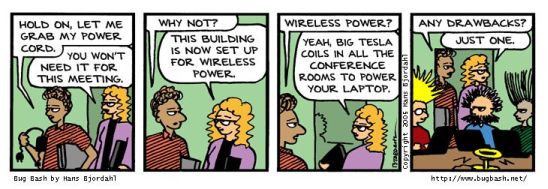Wireless Power
November 15, 2006 - Science
Transmitting power. Science fiction, right? How could anyone transmit power through the air without a giant arc of electricity? Well, it looks like some folks at MIT are working on it. I just read an article at Scientific American that describes how researchers hope to make wireless power work. And it actually makes sense.
Magnetics. It's all about magnetics. Set up a magnetic field in a room in such a way that it turns some kind of turbine, and combine that with the power of resonance, which PMD and I learned in a college physics course named after a musical.
Tired of your laptop's battery dying during presentations or bursting into flames? Take heart: scientists are perfecting a new method for transmitting electrical energy from a base station using a technique that resembles a wireless Internet connection. Researchers say that a specially designed device should be able to draw power from a strong magnetic field permeating a room.
The effect, which has not yet been demonstrated, would take advantage of the stationary magnetic field that surrounds a charged loop of metal. This so-called near-field can be powerful-it is what makes an electric motor turn. And in principle its oscillations can induce an electric current in another nearby loop, because dynamic magnetic fields create electric fields and vice versa. The second loop could act as a battery or recharger, but it would normally receive only a slight current because the near field fades rapidly over distance.
The key to boosting the induced current is resonance, says photonics researcher Marin Soljacic of the Massachusetts Institute of Technology. Soljacic and his colleagues propose introducing a short gap in a metal loop and attaching two small disks at each end. When electrified, such an object has a natural, or resonant, frequency that results from current flowing back and forth along the loop from one disk to the other.
If two loops have the same frequency, one should be able to receive energy from the other through the magnetic near field-much like two identical tuning forks brought into close proximity, the group reasoned. From a few meters away, the rate of energy transferred in this way might reach tens of watts, or enough to power a laptop, according to simulations Soljacic presented November 14 at a meeting of the American Institute of Physics. "The results are strongly encouraging but the real test of the thing will be experiments, which we are working on now." Soljacic says.
"It's a great idea. I think a lot of people will be very surprised by it," says photonics expert John Pendry of Imperial College London. It could be very useful, he says, in specialized applications such as space exploration, say to power a rover within a few meters of a power supply. He questions whether people would accept it in their homes, though, given concerns over the effect of power lines and cell phones on the body. "I think they'll have a problem convincing people it's okay," he says.

Comments on Wireless Power
http://en.wikipedia.org/wiki/Wardenclyffe_Tower